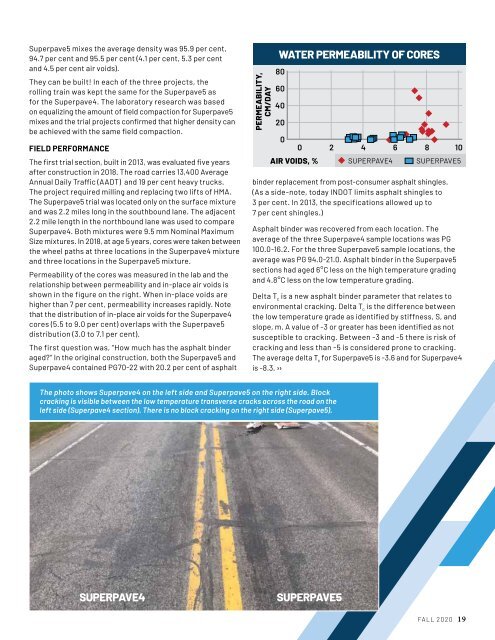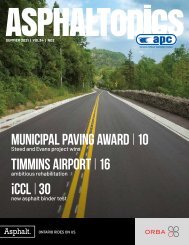ASPHALTopics | Fall 2020 | VOL 33 | NO 3
You also want an ePaper? Increase the reach of your titles
YUMPU automatically turns print PDFs into web optimized ePapers that Google loves.
Superpave5 mixes the average density was 95.9 per cent,<br />
94.7 per cent and 95.5 per cent (4.1 per cent, 5.3 per cent<br />
and 4.5 per cent air voids).<br />
They can be built! In each of the three projects, the<br />
rolling train was kept the same for the Superpave5 as<br />
for the Superpave4. The laboratory research was based<br />
on equalizing the amount of field compaction for Superpave5<br />
mixes and the trial projects confirmed that higher density can<br />
be achieved with the same field compaction.<br />
FIELD PERFORMANCE<br />
The first trial section, built in 2013, was evaluated five years<br />
after construction in 2018. The road carries 13,400 Average<br />
Annual Daily Traffic (AADT) and 19 per cent heavy trucks.<br />
The project required milling and replacing two lifts of HMA.<br />
The Superpave5 trial was located only on the surface mixture<br />
and was 2.2 miles long in the southbound lane. The adjacent<br />
2.2 mile length in the northbound lane was used to compare<br />
Superpave4. Both mixtures were 9.5 mm Nominal Maximum<br />
Size mixtures. In 2018, at age 5 years, cores were taken between<br />
the wheel paths at three locations in the Superpave4 mixture<br />
and three locations in the Superpave5 mixture.<br />
Permeability of the cores was measured in the lab and the<br />
relationship between permeability and in-place air voids is<br />
shown in the figure on the right. When in-place voids are<br />
higher than 7 per cent, permeability increases rapidly. Note<br />
that the distribution of in-place air voids for the Superpave4<br />
cores (5.5 to 9.0 per cent) overlaps with the Superpave5<br />
distribution (3.0 to 7.1 per cent).<br />
The first question was, “How much has the asphalt binder<br />
aged?” In the original construction, both the Superpave5 and<br />
Superpave4 contained PG70-22 with 20.2 per cent of asphalt<br />
PERMEABILITY,<br />
CM/DAY<br />
WATER PERMEABILITY OF CORES<br />
80<br />
60<br />
40<br />
20<br />
0<br />
0 2 4 6 8 10<br />
AIR VOIDS, % SUPERPAVE4 SUPERPAVE5<br />
binder replacement from post-consumer asphalt shingles.<br />
(As a side-note, today INDOT limits asphalt shingles to<br />
3 per cent. In 2013, the specifications allowed up to<br />
7 per cent shingles.)<br />
Asphalt binder was recovered from each location. The<br />
average of the three Superpave4 sample locations was PG<br />
100.0-16.2. For the three Superpave5 sample locations, the<br />
average was PG 94.0-21.0. Asphalt binder in the Superpave5<br />
sections had aged 6°C less on the high temperature grading<br />
and 4.8°C less on the low temperature grading.<br />
Delta T c is a new asphalt binder parameter that relates to<br />
environmental cracking. Delta T c is the difference between<br />
the low temperature grade as identified by stiffness, S, and<br />
slope, m. A value of -3 or greater has been identified as not<br />
susceptible to cracking. Between -3 and -5 there is risk of<br />
cracking and less than -5 is considered prone to cracking.<br />
The average delta T c for Superpave5 is -3.6 and for Superpave4<br />
is -8.3. ››<br />
The photo shows Superpave4 on the left side and Superpave5 on the right side. Block<br />
cracking is visible between the low temperature transverse cracks across the road on the<br />
left side (Superpave4 section). There is no block cracking on the right side (Superpave5).<br />
SUPERPAVE4<br />
SUPERPAVE5<br />
FALL <strong>2020</strong> 19

















